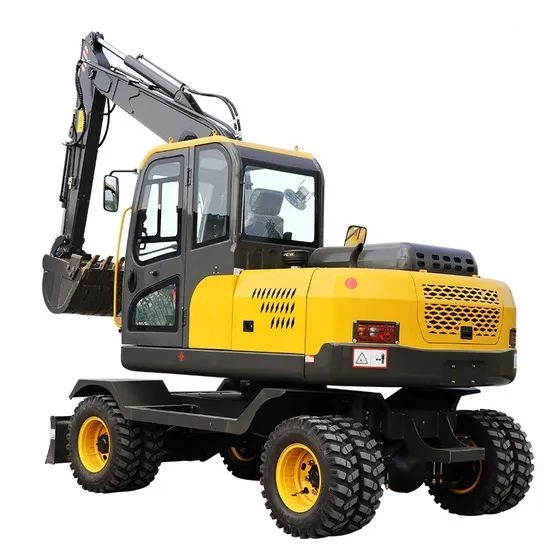Both wheeled excavators and tracked excavators have their own advantages and disadvantages, and there is no absolute "better" option. The choice should be based on specific working conditions, operational needs, and usage scenarios. The following is a comparative analysis from the aspects of core differences and applicable scenarios to help you judge according to actual needs:

I. Comparison of Core Differences
| Comparison Dimension | Wheeled Excavator | Tracked Excavator |
|---|---|---|
| Walking Mode | Tire-driven, similar to a car chassis | Crawler chain-driven with a large ground contact area |
| Moving Speed | Fast (usually 30-50km/h), can directly drive on roads | Slow (usually 5-10km/h), requires a trailer for long-distance transfer |
| Ground Pressure | Large (small tire contact area), high pressure on the ground | Small (crawlers distribute weight), little damage to the ground |
| Terrain Adaptability | Suitable for flat hardened roads (highways, factories, farmland) | Suitable for complex terrains (muddy, mountainous, soft ground, steep slopes) |
| Operational Stability | Poor (weak tire grip, easy to slip or roll over) | Good (strong crawler grip, large support area) |
| Flexibility | Small turning radius, more flexible for moving and steering on site | Large turning radius, requires "in-place U-turn" or large-range detour for steering |
| Maintenance Cost | Lower (maintenance of tires and transmission system is similar to that of cars, and parts are easy to obtain) | Higher (crawlers, tracks, carrier rollers, etc. are easy to wear, and maintenance is complicated) |
| Purchase Cost | Usually lower than tracked excavators of the same tonnage (about 10%-20% lower) | Higher (high manufacturing cost of crawler systems) |
II. Analysis of Applicable Scenarios
Wheeled excavators are more suitable for:
- Urban and road operations
Such as municipal engineering (ditching, crushing, transportation), road maintenance (road repair, collapse cleaning). They can directly go on the road without a trailer, saving transfer time and cost.
Advantage: Fast movement, suitable for frequent transfer between multiple construction sites (such as traveling between multiple municipal points in one day). - Hardened ground operations
Factory areas, warehouses, concrete sites, etc., to avoid the rolling damage of crawlers to hardened roads (crawlers are easy to scratch cement or asphalt roads). - Light-load operations on flat terrain
Farmland transformation, small earthwork excavation, material loading and unloading, etc. The operation intensity is low, the ground is solid, and there is no need for complex terrain adaptability. - Scenarios with high flexibility requirements
Narrow sites (such as factory workshops, community interiors). Wheeled excavators have a small turning radius and are easier to operate in limited spaces.
Tracked excavators are more suitable for:
- Complex terrain operations
Mines, woodlands, wetlands, muddy farmland, steep slopes, etc. The low ground pressure of crawlers can prevent getting stuck, with strong grip and better climbing ability (usually able to climb slopes above 30°, while wheeled ones are mostly within 20°). - Heavy-load operations
Large earthwork excavation, rock crushing, pile foundation operations, etc. The stability of crawlers can support high-intensity excavation and avoid "tail lifting" or slipping during operation. - Soft ground operations
Such as fishpond desilting, river dredging, swamp transformation. Crawlers can distribute the weight of the machine body to prevent getting stuck in mud. - Long-term fixed-site operations
Such as construction site foundation pit excavation, mine stripping. There is no need for frequent transfer, and the slow speed and transfer cost of crawlers are acceptable.
III. Summary: How to Choose?
Choose wheeled excavators: If the operation site is mainly hardened roads, frequent transfer is needed, the operation intensity is medium, and flexibility and transfer efficiency are emphasized, wheeled excavators are preferred.
Choose tracked excavators: If the operation terrain is complex (muddy, mountainous, steep slopes), heavy-load excavation is required, and high requirements are put forward for stability and terrain adaptability, tracked excavators are preferred.
In addition, the use cost should also be considered: wheeled excavators are suitable for short-term rental or small and medium-sized engineering teams (simple maintenance and cost-saving transfer); tracked excavators are suitable for long-term high-intensity operations or large-scale projects (durability and adaptability are more critical).





